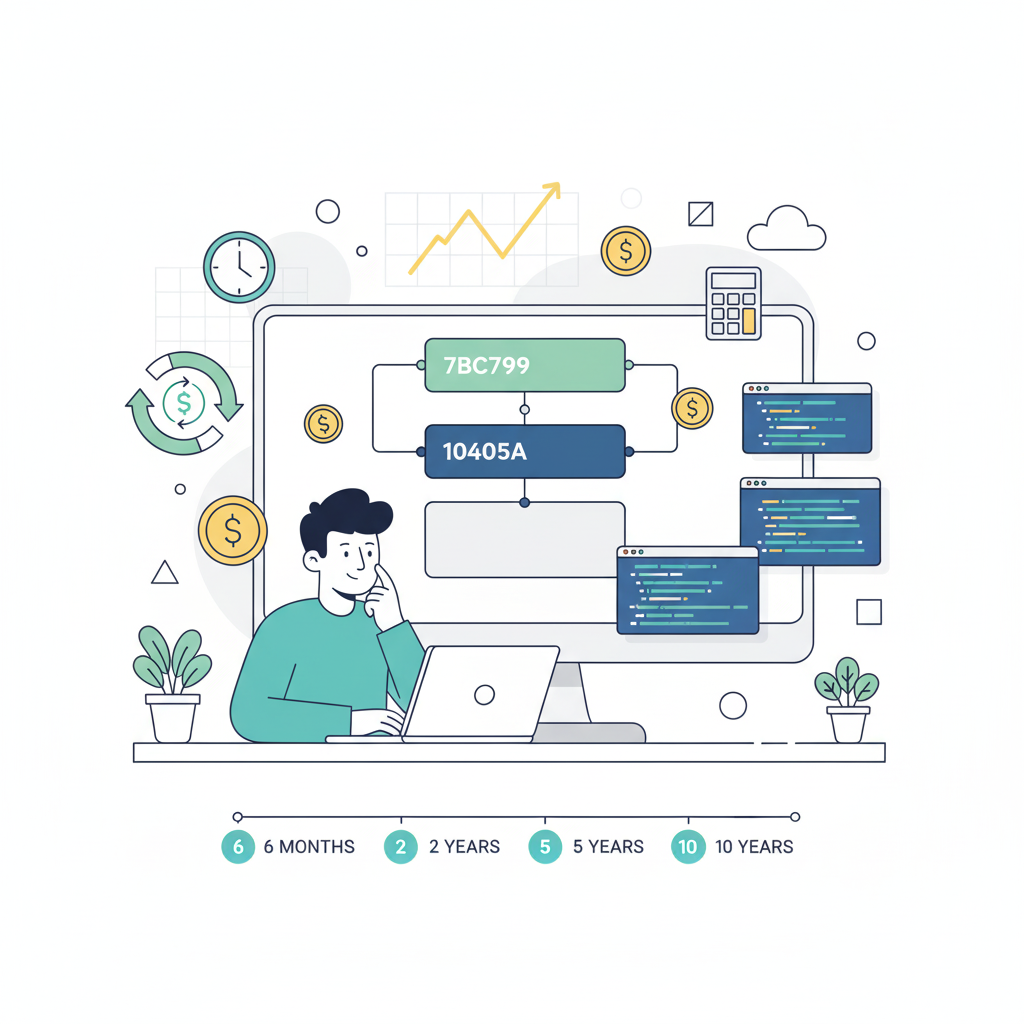Most abstractions fail not because they’re wrong, but because they’re introduced at the wrong time. You’ve probably experienced this yourself—an abstraction layer that seemed brilliant at the time but became technical debt within months. Or worse, you skipped abstraction entirely and ended up with duplicated code across 47 files.
Abstraction timing determines whether you get exponentially increasing returns or exponentially increasing costs. When to abstract matters more than whether to abstract. This analysis builds on the temporal framework foundation for evaluating architectural investments against realistic project timelines.
Good abstractions generate exponentially increasing returns over time, reducing change costs and enabling parallel team development. Poor abstractions create exponentially increasing costs, fighting you at every modification. The difference between these two outcomes usually comes down to timing.
This article provides an analytical framework for calculating abstraction ROI, distinguishing premature from well-timed abstractions, and making timing decisions based on realistic project horizons. You’ll get quantitative methods for calculating returns, the Rule of Three heuristic, case study evidence from Shopify and Stripe, and a decision checklist that transforms architectural choices from gut feelings into data-driven decisions using financial metaphors your stakeholders understand.
The Shopify Database Abstraction Story: Years of Payoff from One Good Decision
Shopify modularised 2.8 million lines of Rails code using Rails Engines, Sorbet, and Packwerk. This abstraction investment enabled parallel team development, reduced change amplification, and maintained velocity during hypergrowth. The compound returns manifested as reduced cycle times, contained technical debt, and the ability to scale to 100+ engineering teams. The lesson? Well-timed abstractions pay dividends for years after the initial investment.
When Shopify needed to refactor their legacy codebase, they faced a choice. They could rewrite everything as microservices—the fashionable approach. Or they could invest in modular architecture within their existing monolith. They chose the monolith, and it paid off.
The strategy used Rails Engines to create module boundaries, Sorbet for type safety, and Packwerk for dependency enforcement. Together, these tools created compile-time safety and runtime boundaries that prevented technical debt from compounding as the codebase grew.
This wasn’t a quick fix. The investment was substantial upfront. But the time horizon was 10+ years for a platform-scale system, which justified the cost. The compound interest effect accelerated over time as more modules were added. Each new module benefited from the abstraction infrastructure already in place.
Modular monoliths provide abstraction benefits without microservices complexity for most teams under 100 engineers. Shopify proved you can scale to billions in revenue on a well-designed modular monolith.
The key insight? They matched their abstraction investment to their time horizon. A 10-year platform justifies significant upfront architecture work. A 6-month project doesn’t.
Abstraction as Investment: Upfront Cost, Ongoing Overhead, Compound Returns
Abstraction investment consists of three components: upfront design and implementation cost, ongoing maintenance overhead, and compound returns from reduced change costs. Good abstractions pay compound interest through reduced coupling, increased velocity, and contained technical debt. Poor abstractions become technical debt themselves, compounding costs rather than benefits.
The investment metaphor matters here. Treating abstractions as capital expenditures rather than operational expenses changes how you evaluate them. You wouldn’t buy a machine for a factory without calculating the payback period. Why treat architectural decisions differently?
Upfront costs include design time, implementation complexity, learning curves, and testing overhead. You’re asking developers to think harder now to make future work easier.
Ongoing overhead includes maintaining abstraction boundaries, documentation, and enforcement mechanisms. Technical debt represents a measurable liability on engineering balance sheets with accumulating interest.
The compound returns mechanism works through preventing change amplification. Without abstraction, changing one thing requires changing many things. With good abstraction, changes stay contained within modules. Organisations with structured tech debt tracking show 47% higher maintenance efficiency.
Financial framing helps communicate architectural value to non-technical stakeholders. Saying “we need to refactor the data layer” gets blank stares. Saying “this investment will reduce feature development time by 30% over the next two years” gets budget approval.
Martin Fowler noted: “Technical debt should be like financial debt—used wisely, with a plan to pay it back.” The same applies to abstraction investment.
The ROI Calculation Framework: A Formula with Real Numbers
Abstraction ROI = (Change Cost Reduction × Change Frequency × Time Horizon) – (Upfront Cost + Ongoing Overhead)
Hard ROI includes measurable metrics like reduced cycle time, fewer defects, and faster feature delivery. Soft ROI captures developer experience, knowledge transfer, and team velocity improvements. CBAM (Cost Benefit Analysis Method) provides a formal framework for high-stakes architectural decisions. Proper abstraction longevity assessment and investment horizon determination ensure timing aligns with realistic project lifespans.
Let’s work through a concrete example. You’re considering abstracting your database layer behind an interface. Here’s how to calculate whether it’s worth it.
Upfront cost: Two senior developers, two weeks = $20,000. Ongoing overhead: maintenance, documentation, updates = $5,000 per year. Change cost reduction: Database changes currently take 3 days across 8 files. With abstraction, they’d take 1 day in 2 files. Savings = 2 days per change. Change frequency: You make database changes about 20 times per year. Time horizon: You expect this system to run for 5 years.
The calculation: (2 days × $1,000 per day × 20 changes × 5 years) – ($20,000 + $5,000 × 5 years) = $200,000 – $45,000 = $155,000 return.
That’s a clear positive ROI. But what if your time horizon was only 1 year? Then: (2 days × $1,000 × 20 changes × 1 year) – ($20,000 + $5,000) = $40,000 – $25,000 = $15,000 return. Still positive, but much tighter. Any estimation error could flip it negative.
Technical project ROI includes three components: migration costs, business disruption, and performance improvements. You need to account for all three.
Hard ROI metrics are quantifiable. Track deployment frequency, cycle time, change failure rates, and defect density. These numbers go into dashboards. They convince CFOs.
Soft ROI factors matter too but they’re harder to measure. Developer satisfaction, onboarding time, cognitive load, and team velocity all improve with good abstractions. Engineering ROI frameworks must account for both quantitative metrics and qualitative indicators.
CBAM methodology comes into play for platform-level choices where the stakes are high. Use simple ROI calculations for team-level decisions. Use CBAM when the abstraction affects platform-wide architecture or requires C-level approval.
Time horizon drives most abstraction ROI calculations. A 6-month project can’t support much abstraction investment. A 10-year platform can support substantial upfront architecture work. Understanding time-bounded investment decisions ensures abstraction timing matches business realities rather than engineering idealism.
Time Horizon Alignment: When to Abstract at 6 Months, 2 Years, 5 Years, and 10 Years
Six-month projects should avoid abstraction except for proven patterns—the payback period exceeds project lifespan. Two-year projects should abstract after the third occurrence using the Rule of Three. Five-year platforms justify upfront abstraction investment for core architectural layers. Ten-year systems need proactive abstraction planning for long-term maintainability and team scaling.
For 6-month horizons, accept duplication and focus on delivery. The cost of abstraction won’t be recovered before the project ends. If you’re building a prototype, a seasonal campaign site, or a time-limited experiment, keep it simple. Copy-paste is fine.
For 2-year horizons, apply the Rule of Three. When you see the same pattern three times, abstract it. This gives patterns time to stabilise before you commit to an interface.
For 5-year horizons, balance upfront architecture with emergent design. Some abstractions are obvious from the start—your authentication system, your data access layer, your API versioning strategy. Invest in these upfront. Other abstractions should emerge as patterns become clear.
For 10-year horizons, strategic abstraction planning becomes necessary. You’re building a platform that will support hundreds of developers and thousands of features. At this level, architectural decisions address near-term reliability needs while avoiding choices requiring significant rework for future horizons.
Team scale interacts with time horizon. A solo developer working on a 10-year project can tolerate more technical debt than a 50-person team working on a 2-year project. Abstractions reduce coordination costs by enabling parallel work.
Real-world examples help calibrate your intuition. A mobile app for a marketing campaign—6 month horizon, minimal abstraction. An internal tool for 10 people—2 year horizon, Rule of Three applies. A SaaS product targeting enterprise customers—5 year horizon, invest in core abstractions. A platform like AWS or Stripe—10+ year horizon, proactive abstraction planning.
Stripe’s API Versioning Investment: Enabling Long-Term Backwards Compatibility
Stripe invested heavily in API versioning abstraction to provide perpetual backwards compatibility. This abstraction enables customers to upgrade at their own pace without breaking changes. The compound returns include customer retention, reduced support costs, and competitive differentiation. The long time horizon (10+ year platform) justified the substantial upfront investment in the versioning system.
When you’re building an API that thousands of businesses depend on, breaking changes are business-threatening. Stripe understood this from day one.
The versioning abstraction allows Stripe to run old and new APIs in parallel, routing clients based on request headers. This means a customer who integrated three years ago still works fine, while new customers get the latest features. No forced migrations. No breaking changes.
The upfront investment was substantial. Building the versioning infrastructure, creating migration tooling, and designing backwards-compatible evolution patterns required significant engineering time. The ongoing overhead is real too.
But the compound returns are clear. Customer trust increases when you promise “we won’t break your integration.” Churn decreases when competitors force painful migrations while you don’t. Support costs drop when customers can upgrade on their timeline. These benefits accumulate year after year.
The ROI calculation for Stripe’s versioning probably looked something like this over a 10-year horizon. Upfront cost: maybe 6 months of senior engineering time. Ongoing overhead: version maintenance, testing, documentation. Returns: reduced churn (worth millions in recurring revenue), competitive advantage (worth even more), support cost reduction (worth hundreds of thousands annually).
Stripe’s time horizon was 10+ years from the start. They were building infrastructure for the internet. That horizon justifies substantial abstraction investment that would be unjustifiable for shorter timelines.
Anti-Pattern: When Premature Abstraction Becomes Technical Debt
Premature abstraction occurs when abstraction layers are introduced before patterns are clear or needs are validated. These wrong abstractions create ongoing maintenance costs without providing benefits, becoming technical debt themselves. The compound interest works in reverse—each change fights the wrong abstraction, accumulating costs exponentially. Sandy Metz’s principle applies: “Duplication is far cheaper than the wrong abstraction.”
The YAGNI principle—”You aren’t gonna need it”—exists for a reason. Overzealous abstraction creates codebases with spiralling architecture, interfaces and abstractions everywhere. You end up maintaining complexity that provides no value. Understanding when simplicity beats abstraction helps avoid premature optimization traps while keeping code maintainable.
Common triggers for premature abstraction include over-engineering, speculative generality, and misapplied design patterns. You read about the Strategy pattern and decide everything needs to be pluggable. You anticipate future requirements and build flexibility you never use. The abstraction overhead costs in these scenarios often exceed any future benefits.
The compounding cost mechanism works through change amplification. A change that should touch one file now touches three—the implementation, the interface, and the factory or dependency injection configuration.
AI-generated code shows 8-fold increase in code duplication frequency during 2024. Interestingly, this includes both too little abstraction (copy-paste) and too much abstraction (over-engineered patterns).
Recovery strategies exist but they’re costly. Recognising a wrong abstraction is the first step. Unwinding it is the second. Sometimes you can refactor incrementally, removing the abstraction layer gradually. Sometimes you need to rewrite sections to escape the architectural trap. In extreme cases, when abstractions become liabilities that compound costs faster than benefits, strategic technical bankruptcy becomes the rational choice.
The refactor versus rewrite decision depends on how deeply the wrong abstraction has metastasised. If it’s contained to one module, refactoring works. If it’s spread across 50 files and enforced by tooling, rewriting might be faster. Understanding how abstraction debt forcing rewrites occurs helps recognize when incremental improvement is no longer viable.
Distinguishing premature from unnecessary is important. Premature abstractions introduce the right abstraction too early—a timing problem. Unnecessary abstractions create abstractions that will never be needed—a wrong abstraction problem. Premature abstractions often become valuable later when patterns actually emerge. Unnecessary abstractions never do.
Implementation Timing: Recognising When to Introduce Abstraction Layers
The Rule of Three provides a practical heuristic—wait for the third occurrence of a pattern before abstracting. Pattern recognition skills are necessary for distinguishing coincidental similarity from true patterns. Tight coupling and change amplification signal that abstraction investment would pay off. Team scale inflection points often justify abstraction investment to enable parallel development.
Martin Fowler and Don Roberts formulated the Rule of Three. Wait for the third occurrence of duplication before abstracting. This balances avoiding premature abstraction (abstracting after one or two instances) with avoiding excessive duplication (waiting too long).
Why three, not two? Because two occurrences might be coincidence. Three occurrences suggest a genuine pattern. And by the third occurrence you understand the variation between instances. You know which parts are truly common and which parts need to be parameters or hooks in your abstraction.
Technical signals that abstraction ROI would be positive include tight coupling where files change together, change amplification where one logical change requires many file modifications, increasing cycle times as coordination overhead grows, and high defect density in coupled areas.
Team signals matter too. Watch for coordination overhead, merge conflicts in the same areas, knowledge silos where only one person understands a domain, and onboarding difficulty for new developers.
Modular architecture patterns help structure abstractions to prevent technical debt. Clear module boundaries, explicit interfaces, and dependency management keep abstractions maintainable.
Implementation approach matters. Incremental abstraction beats big-bang rewrites. Refactor by making small, manageable changes to one component or module at a time. Test frequently after each change to catch issues early.
Decision Checklist: Should I Abstract This Now?
The abstraction timing checklist synthesises ROI calculations, pattern recognition, time horizon analysis, and team scale considerations. Key questions include: Has this pattern occurred three times? What is the time horizon? What is the change frequency? Does tight coupling exist? Use the checklist to transform abstraction decisions from intuition to systematic analysis. Document decisions to build organisational knowledge about abstraction timing.
Here’s the complete checklist. Run through it whenever you’re considering abstraction.
Pattern validation: Has this pattern occurred at least three times? Are the occurrences truly similar, solving the same type of problem? Or is the similarity superficial? If you haven’t seen it three times yet, wait.
Time horizon questions: What is the expected project lifespan? Six months, two years, five years, or ten years? When will the benefits exceed the costs? If your horizon is under a year, you need very high change frequency to justify abstraction.
ROI questions: What is the change frequency for this pattern? Monthly? Weekly? Daily? What is the cost of changes without abstraction? How much would abstraction reduce that cost? Run the actual ROI calculation with real numbers.
Team questions: How large is the team? Solo developer, 5-10 people, 20+ people? Is parallel development needed? Could multiple people or teams work on this area simultaneously with proper abstraction? Teams of 5-10 should apply the Rule of Three. Larger teams often need proactive abstraction planning.
Technical questions: Does tight coupling exist? Are files changing together? Is change amplification occurring where one logical change requires modifications across many files? What is the defect density in this area?
Risk questions: What is the cost of getting the abstraction wrong? Can it be unwound if needed, or would it be deeply embedded? How confident are you in the pattern?
Documentation template helps here. Record your abstraction decisions: what pattern you saw, why you chose to abstract (or not abstract) at this time, what ROI you projected, and what actually happened. Six months later, review the decision.
Learning process improves through decision retrospectives. Look back at abstractions you introduced. Which ones paid off? Which became technical debt? What signals did you miss? Pattern recognition is a skill that improves with deliberate practice.
The checklist isn’t meant to be bureaucratic. It’s meant to structure thinking. Two minutes with this checklist beats two hours of unfocused architectural debate.
FAQ Section
What is the difference between premature abstraction and unnecessary abstraction?
Premature abstraction introduces the right abstraction too early (timing problem), while unnecessary abstraction creates abstractions that will never be needed (wrong abstraction problem). Premature abstractions often become valuable later; unnecessary abstractions never do. The Rule of Three helps avoid both by waiting for patterns to emerge.
How do you measure the interest rate on technical debt from tight coupling?
Track metrics like change amplification ratio (how many files change together), cycle time increases over time, defect density in coupled areas, and merge conflict frequency. Rising trends indicate compound interest accumulation. Compare these to modular areas to quantify the coupling cost.
Should I use microservices or a modular monolith for abstraction?
Modular monoliths provide abstraction benefits without microservices complexity for most teams under 100 engineers. As demonstrated in the Shopify case study above, you can scale to billions in revenue on a modular monolith. Choose microservices only when organisational boundaries, independent deployment, or technology heterogeneity justify the overhead.
How do I build a business case for architectural refactoring?
Use the ROI calculation framework to quantify both hard ROI (cycle time reduction, defect reduction) and soft ROI (developer velocity, team scaling). Frame technical debt using compound interest metaphors. Project costs over the time horizon. Use CBAM for high-stakes decisions requiring formal justification.
What percentage of development time should go to refactoring versus features?
Industry research suggests 15-25% of capacity for established codebases. New projects need less; legacy systems need more. Adjust based on technical debt interest rate metrics. Track cycle time and defect trends to calibrate the percentage. Good abstractions reduce the refactoring percentage needed.
When should I refactor versus rewrite to introduce new abstractions?
Refactor when the existing structure can be incrementally improved and the time horizon supports gradual change (2-5 years). Refactoring typically costs around one-third as much as a rewrite. Rewrite when tight coupling makes incremental change impossible or when the time horizon is short (need results in 6-12 months). As demonstrated in the Shopify case study, incremental refactoring works at massive scale.
How does team size affect abstraction timing decisions?
Larger teams justify earlier abstraction investment to enable parallel development and reduce coordination overhead. Solo developers can tolerate more duplication. Teams of 5-10 should apply the Rule of Three. Teams of 20+ often need proactive abstraction planning. Team scaling inflection points trigger abstraction investment.
What is the Cost Benefit Analysis Method (CBAM) for architecture decisions?
CBAM is a formal methodology for evaluating architectural decisions based on quantified costs, benefits, and risks. It involves stakeholder elicitation, scenario development, utility calculation, and sensitivity analysis. Use CBAM when abstraction decisions involve high stakes (platform-level choices) or require executive justification.
How do Rails Engines, Sorbet, and Packwerk work together in Shopify’s modular monolith?
Rails Engines provide module boundaries and namespaces. Sorbet adds static typing to enforce interfaces between modules. Packwerk enforces dependency rules and prevents coupling from creeping back. Together they create compile-time safety and runtime boundaries that prevent technical debt compounding, demonstrating how tooling supports abstraction investment.
What is the Rule of Three and who created it?
Martin Fowler and Don Roberts formulated the Rule of Three: wait for the third occurrence of duplication before abstracting. This heuristic balances avoiding premature abstraction (abstracting after one or two instances) with avoiding excessive duplication (waiting too long). It’s a practical implementation of pattern recognition for everyday development decisions.
How do I know if my abstractions are paying compound interest or accruing compound debt?
Monitor leading indicators: cycle time trends, change amplification metrics, defect density, and developer velocity. Positive compound interest shows as improving or stable metrics despite growth. Compound debt shows as degrading metrics over time. Compare module-level metrics to identify which abstractions are succeeding versus failing.
Can good abstractions ever become technical debt?
Yes, through environmental change. Abstractions that were well-timed can become debt when requirements shift fundamentally, team size changes dramatically, or time horizons shorten unexpectedly. The “code half-life” concept applies: architectural decisions have decay rates. Recognise when abstractions have outlived their usefulness and plan migration paths.












